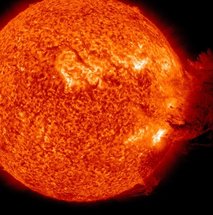
WASHINGTON – A solar flare erupted from the sun in an impressive display captured by NASA cameras, but scientists say the medium-sized event will have a minimal impact, if any, on Earth.
The flare peaked early Tuesday and created a large cloud that appeared to cover almost half the surface of the sun, NASA said. A cloud of charged particles erupted from the sun's outer atmosphere and is expected to pass by Earth late Wednesday or early Thursday, causing a minor disruption to Earth's magnetic field, according to the National Weather Service's Space Weather Prediction Center in Boulder, Colo.
"This wasn't really such a big event," said Michael Hesse, chief of the space weather laboratory at NASA's Goddard Space Flight Center in Greenbelt, Md. "It was spectacular to watch, but not big in terms of hazards to the Earth."
At most, the cloud that erupted from the sun may cause some brief interruptions to high-frequency radio communications, especially closer to the North and South poles, said Joe Kunches, a space scientist at SWPC. Some global positioning devices also may make tiny errors, he said.
"It doesn't look like it's going to be a direct hit on the Earth," Kunches said. "It's going to be, if you use a baseball analogy, a little bit low and outside on the pitch."
The aurora borealis also may be more visible Thursday or Friday night, he said.
Images of the flare were recorded by an orbiting satellite called the Solar Dynamics Observatory. The photos and video were the most spectacular that the satellite has captured since it was launched last year, Hesse said.
A much larger solar flare erupted Saturday, but NASA didn't capture images because it happened on the side of the sun opposite Earth, Hesse said. Scientists have been expecting an increase in solar activity because the sun is moving into a more volatile period of an 11-year cycle in which its magnetic field reverses its orientation.
"The sun has woken up and is becoming more active as we approach the solar maximum," expected in 2013, Hesse said.
Source: By BEN NUCKOLS, Associated Press

Recommended Comments
There are no comments to display.
Join the conversation
You can post now and register later. If you have an account, sign in now to post with your account.